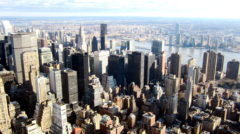More and more people are living in cities, and within 45 years, 80% of the world’s population will be city dwellers, compared to 50% today. But due to insufficient planning, modern cities — the growth engines of national economies — are increasingly becoming cold and bleak.
Danish architect Jan Gehl believes that contemporary cities, like those of the past, should be built on a human and intimate scale, and that city planning should not be focused on cars and traffic flows. These ideas are explored by Andreas Dalsgaard in his thoughtful documentary, The Human Scale, which opened in Toronto on Nov. 8
From about the prehistoric era to ancient times, people lived together in tribes and clans, but as cities grew larger, this concept of togetherness gradually faded away. In the modern city, it is vanishing altogether.
Dalsgaard looks at six cities to warn of the danger of short-sighted planning and unchecked growth and to illustrate the thesis that fresh thinking and reform are necessary to create liveable cities in the future.
In Chongqing, rampant urbanization poses a real challenge as old neighborhoods and traditional Chinese houses are demolished in the name of progress. Here, as elsewhere, cars and real estate development generate growth, which often comes at the expense of quality of life. Lately, however, city planners have begun to rectify their mistakes.
During the 1960s, Copenhagen enbraced the approach that China has adopted. Recognizing that Copenhagen was turning into an unattractive city structured around cars, planners took steps to create more public spaces and 350 kilometres of bike lanes for the pleasure of its inhabitants.

Like Copenhagen, New York was once in thrall to the automobile. In the interests of traffic efficiency, huge sums were allotted for the construction of expressways and roads. As New Yorkers learned that an excess of cars can destroy a human environment, pedestrian spaces were built, even in a congested milieu like Times Square.
In Melbourne, urban decay and high real estate prices drove people into suburbs, which can produce bad outcomes like social isolation and economic hardship. Cognizant that Melbourne was facing a problem of major proportions, the municipality devised a plan to lure people back to the city. Thanks to judicious planning, streets became people’s “living rooms,” in the words of one observer.
Out of necessity, Dhaka, the fastest growing city in the world, is learning how to cope with modernity. Since 500,000 people from the countryside pour into Bangladesh’s capital annually, Dhaka is channelling more funds into people-friendly pedestrian areas. Yet the city is vulnerable, lying in an earthquake zone.
Christchurch, in New Zealand, was hit hard by an earthquake in 2012 and is rebuilding itself. Before reconstruction was undertaken, city hall asked citizens for suggestions on how to proceed. They submitted 106,000 ideas, which boiled down to a few essentials: build a low-rise city with plenty of public spaces, gardens, bike lanes and a lively central core.
As Dalsgaard suggests, a city should be an organic entity and much more than the sum of bricks and mortar. The main point being made is that many cities are car dominant still even with the amount of pedestrians choosing to walk, pedestrian safety comes at a cost in cities – having to be much more alert than someone who lives in a country environment for example, and many more drivers becoming reckless because of the city driving environment, there’s some great info here on pedestrian safety and laws if it interests you.